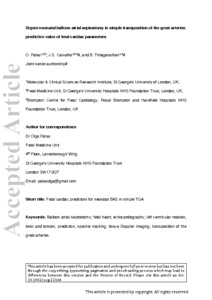Patey, O; Carvalho, JS; Thilaganathan, B
(2021)
Urgent neonatal balloon atrial septostomy in simple transposition of the great arteries: predictive value of fetal cardiac parameters.
Ultrasound Obstet Gynecol, 57 (5).
pp. 756-768.
ISSN 1469-0705
https://doi.org/10.1002/uog.22164
SGUL Authors: Thilaganathan, Baskaran
![[img]](https://openaccess.sgul.ac.uk/112213/6.hassmallThumbnailVersion/uog.22164.pdf)  Preview |
|
PDF
Accepted Version
Available under License ["licenses_description_publisher" not defined].
Download (1MB)
| Preview
|
Abstract
Objectives
To investigate the impact of abnormal perinatal loading conditions on cardiac geometry and function in term fetuses and neonates with transposition of the great arteries with intact interventricular septum (simple TGA), and to explore the predictive value of fetal cardiac parameters for an urgent balloon atrial septostomy (BAS) after birth.
Methods
This was a prospective longitudinal follow‐up study of women delivering at term, including both uncomplicated pregnancies with normal outcome and pregnancies affected by fetal simple TGA. Conventional, spectral‐tissue Doppler and speckle‐tracking echocardiographic parameters were obtained within 1 week before delivery and within the first few hours after delivery. Neonates with simple TGA that required urgent BAS were assessed after the procedure and before corrective arterial switch surgery. Cardiac parameters were normalized by cardiac cycle length, ventricular end‐diastolic length or end‐diastolic dimension, as appropriate. Fetal and neonatal cardiac parameters were compared between simple‐TGA cases and controls, and perinatal changes in the simple‐TGA group were assessed. Receiver‐operating‐characteristics (ROC)‐curve analysis was used to assess the predictive value of fetal cardiac parameters for urgent BAS after birth in the simple‐TGA group.
Results
A total of 67 pregnant women delivering at term were included in the study (54 normal pregnancies and 13 with a diagnosis of fetal simple TGA). Compared with normal term fetuses, term fetuses with simple TGA exhibited more globular hypertrophied ventricles, increased biventricular systolic function and diastolic dysfunction (right ventricular (RV) sphericity index (SI), 0.58 vs 0.54; left ventricular (LV)‐SI, 0.55 vs 0.49; combined cardiac output (CCO), 483 vs 406 mL/min/kg; LV torsion, 4.3 vs 3.0 deg/cm; RV isovolumetric relaxation time (IVRT′), 127 vs 102 ms; P < 0.01 for all). Compared with normal neonates, neonates with simple TGA demonstrated biventricular hypertrophy, a more spherical right ventricle and altered systolic and diastolic functional parameters (RV‐SI, 0.61 vs 0.43; RV myocardial performance index, 0.47 vs 0.34; CCO, 697 vs 486 mL/min/kg; LV‐IVRT′, 100 vs 79 ms; RV‐IVRT′, 106 vs 71 ms; P < 0.001 for all). Paired comparison of neonatal and fetal cardiac indices in the simple‐TGA group showed persistence of the fetal phenotype, increased biventricular systolic myocardial contractility and CCO, and diastolic dysfunction (RV systolic myocardial velocity (S′), 0.31 vs 0.24 cm/s; LV‐S′, 0.23 vs 0.18 cm/s; CCO, 697 vs 483 mL/min/kg; LV torsion, 1.1 vs 4.3 deg/cm; P < 0.001 for all). Several fetal cardiac parameters in term fetuses with simple TGA demonstrated high predictive value for an urgent BAS procedure after birth. Our proposed novel fetal cardiac index, LV rotation‐to‐shortening ratio, as a potential marker of subendocardial dysfunction, for a cut‐off value of ≥ 0.23, had an area under the ROC curve (AUC) of 0.94, sensitivity of 100% and specificity of 83%. For RV/LV end‐diastolic area ratio ≥ 1.33, pulmonary‐valve‐to‐aortic‐valve‐dimension ratio ≤ 0.89, RV/LV cardiac output ratio ≥ 1.38 and foramen‐ovale‐dimension‐to‐total‐interatrial‐septal‐length ratio ≤ 0.27, AUC was 0.93–0.98, sensitivity was 86% and specificity was 83–100% for all.
Conclusions
Simple‐TGA fetuses exhibited cardiac remodeling at term with more profound alterations in these cardiac parameters after birth, suggestive of adaptation to abnormal loading conditions and possible adaptive responses to hypoxemia. Perinatal adaptation in simple TGA might reflect persistence of the abnormal parallel arrangement of cardiovascular circulation and the presence of widely patent fetal shunts imposing volume load on the neonatal heart. The fetal cardiac parameters that showed high predictive value for urgent BAS after birth might reflect the impact of late‐gestation pathophysiology and progressive hypoxemia on fetal cardiac geometry and function in simple TGA. If these findings are validated in larger prospective studies, detailed cardiac assessment of fetuses with simple TGA near term could facilitate improvements in perinatal management and refinement of the timing of postnatal intervention strategies to prevent adverse pregnancy outcomes.
| Item Type: |
Article
|
| Additional Information: |
This is the peer reviewed version of the following article: Patey, O., Carvalho, J.S. and Thilaganathan, B. (2021), Urgent neonatal balloon atrial septostomy in simple transposition of the great arteries: predictive value of fetal cardiac parameters. Ultrasound Obstet Gynecol, 57: 756-768, which has been published in final form at https://doi.org/10.1002/uog.22164. This article may be used for non-commercial purposes in accordance with Wiley Terms and Conditions for Use of Self-Archived Versions. |
| Keywords: |
Balloon atrial septostomy, echocardiography, fetal heart, left ventricular rotation, twist and torsion, prediction, speckle tracking, tissue Doppler imaging, transposition of the great arteries, 1114 Paediatrics and Reproductive Medicine, Obstetrics & Reproductive Medicine |
| SGUL Research Institute / Research Centre: |
Academic Structure > Molecular and Clinical Sciences Research Institute (MCS) |
| Journal or Publication Title: |
Ultrasound Obstet Gynecol |
| ISSN: |
1469-0705 |
| Language: |
eng |
| Dates: |
| Date | Event |
|---|
| 3 May 2021 | Published | | 30 July 2020 | Published Online | | 9 July 2020 | Accepted |
|
| Publisher License: |
Publisher's own licence |
| Projects: |
| Project ID | Funder | Funder ID |
|---|
| UNSPECIFIED | Royal Brompton and Harefield Hospital Charity | UNSPECIFIED | | 14EDI01 | SPARKS Charity | UNSPECIFIED |
|
| PubMed ID: |
32730671 |
 |
Go to PubMed abstract |
| URI: |
https://openaccess.sgul.ac.uk/id/eprint/112213 |
| Publisher's version: |
https://doi.org/10.1002/uog.22164 |
Statistics
Item downloaded times since 06 Aug 2020.
Actions (login required)
 |
Edit Item |



